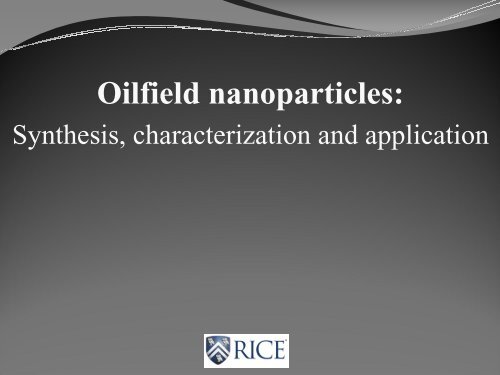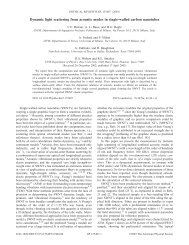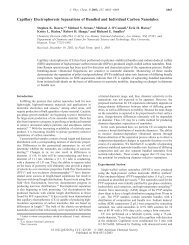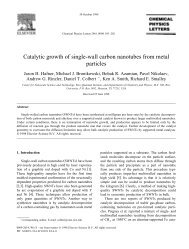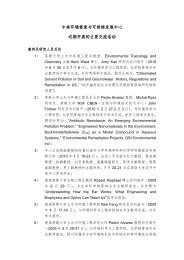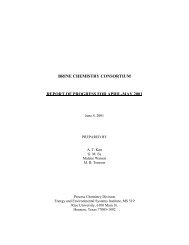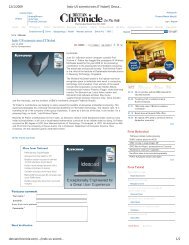Oilfield nanoparticles: Synthesis, characterization and application.
Oilfield nanoparticles: Synthesis, characterization and application.
Oilfield nanoparticles: Synthesis, characterization and application.
- No tags were found...
You also want an ePaper? Increase the reach of your titles
YUMPU automatically turns print PDFs into web optimized ePapers that Google loves.
Why nano?• Nanoparticles is able to effectively transport ina reservoir/formation;• Nanoparticles offer us the potential <strong>application</strong>in oilfield scale treatment, with enhancedmobility <strong>and</strong> performance.
Background information:Common Methods of <strong>nanoparticles</strong> <strong>Synthesis</strong>• Co-precipitation process• Mechanochemical reaction• Hydrothermal• Surfactant template <strong>and</strong> sol-gel techniques• Precipitation in microemulsion• Microwave processing
Previous work of Dr. Heather ShipleySorption of DTPMP to Metal Oxide Nanoparticles1000(a) 20 nm Iron Oxide (b) 145 nm titanium oxide (anatase).55305425q (mg/g)10010w/o Caw/ CapIP535251pIPq (mg/g)2015105w/o Caw/ Ca15000 10 20 30 400 2 4 6 8 10C (mg/L)C (mg/L)(a) Adsorption of DTPMP to Iron Oxide (b) Adsorption of DTPMP to anatase
Previous Work of Dr. Dong Shen<strong>Synthesis</strong> <strong>and</strong> transport of Ca-DTPMP NanoparticlesCa-Phn in DIW Ca-Phn in PPCA Ca-Phn nanofluidC/Co/%100755025Breakthrough in s<strong>and</strong>stone media00 3 6 9 12 15volume/mlDTPMP (mg/L)1000010001001010.10.01Overflush with calcium brineOverflush with KCl brine0.1 1 10 100 1000 10000pore volume(a) Breakthrough in calcite (b) Flow back in calcite with 1%KCl
Background information: Surfactant• Surfactant (surface‐active‐agent): a substance that hasthe property of adsorbing onto the surface of thesystem <strong>and</strong> of altering the surface propertyremarkably. (M. J. Rosen)• Cationic surfactant: The surface‐active portion of themolecules bears a positive charge;Tetradodecylammonium bromide
Background information:• Anionic surfactant: The surface‐active portion of themolecules bears a positive chargeSodium dodecyl sulfate• Non‐ionic surfactant: The surface‐active portion ofthe molecules bears no apparent ionic charge.Tween 20 (Polyoxyethylene (20) sorbitan monolaurate )
<strong>Synthesis</strong> route for <strong>nanoparticles</strong>:Step 1 Nucleation• 4Ca 2+ + DTPMP Ca 4 H 2 DTPMP• 4.5Zn 2+ + DTPMP Zn 4.5 H 1 DTPMP• The metal‐Phn precipitate was fabricated upon contactwith each other, followed by surface coating withsurfactant, inhibiting the further nucleation <strong>and</strong> crystalgrowth.
<strong>Synthesis</strong> route for <strong>nanoparticles</strong>:Step 2 Surface coating with surfactantA surfactant‐assisted synthesis route was developed to formMetal‐Phn <strong>nanoparticles</strong>, without external energy input.
<strong>Synthesis</strong> schematicSyringePumpVariable conditions include:TemperatureTitration speedpHCa vs. Phn mass ratio24mL PhosphoatepH=9.150mL 80 o CCaCl 2/ZnCl 2<strong>and</strong> surfactant• The metal-Phn precipitate was formed instantaneouslyupon injection of phosphonate under constant stirring;• Optimal synthetic condition was chosen asLow injection rate, 80 o C, pH=6.5 <strong>and</strong> M: Phn=4.5
AgendaNano-<strong>Synthesis</strong>CharacterizationTransport inCalcite columnConclusions• Solid <strong>characterization</strong>:•Instrumental analysis ( BET, XRD & FT-IR)• Electron microscopic image (TEM & SEM)• Slurry stability
X-Ray Diffraction: Ca-Phn800Ca-DTPMP XRD spectrumIntensity (counts)600400200031.845.556.5 75.50 20 40 60 80 1002 thetaX-ray diffraction indicated of the microcrystalline structureof fabricated Ca-Phn particles
X-Ray Diffraction: Zn-Phn600Zn-DTPMP XRD spectrumIntensity (counts40020031.6845.556.575.400 20 40 60 80 1002 thetaX-ray diffraction indicated of the microcrystalline structureof fabricated Zn-Phn particles
Fourier transform infrared spectroscopyAbsorbance0.60.50.40.30.20.10-0.1-0.2-0.3996109014601660FT-IRCa-Phn-A1 (surf)Ca-Phn A2 (No surf)Ca-Phn-B2 (70C, w/ surf)Ca-Phn C2( w/ surf)0 1000 2000 3000 4000 5000Wave number(cm-1)• 1660 cm‐1: surfact adsorbed hydroxyl group;• 1460 cm‐1: C‐H bending in –CH2‐ groups;• 1090 cm‐1: phosphonate P‐O‐Metal;• 996cm‐1: P‐C stretching vibration
BET surface area analysisPorous structure ofsolid Metal‐Phn can berevealed by the BETsurface area of around30 m 2 /g
Scanning electron microscopeCa‐DTPMP w/TTAB Zn‐DTPMP w/SDS80 o C 80 o CSEM image shows the porous structure of theobtained metal-Phn <strong>nanoparticles</strong>
Transmission electron microscopyCa-Phn NanoparticlesCa-Phn no surfactant room T Zn-Phn no surfactant 80 o Cw/ TTAB w/ TTAB w/ Tween23 o C 80 o C 23 o C
Transmission electron microscopyZn-Phn Nanoparticlesw/ SDS w/TTAB w/Tween80 o C 80 o C 80 o CCa-DTPMP suspension w/TTAB Zn-DTPMP suspension w/SDS
Elemental analysis5Effect of pH on Zn-P ratioZn:P ratio of precipitate4.543.532.53 5 7 9 11Intial pH of NaDTPMPAs for Ca-Phn, under near neutral pH, Ca: Phn=4.5:1;As for Zn-Phn, ratio of Zn to Phn depends on the slurry pH
Slurry Stability: Ca-DTPMPw/o TTAB w/ TTAB w/TTAB <strong>and</strong> PPCA1% KCl 2% KCl 2% KClAfter two weeks of static stabilization, Ca-Phophonate withTTAB surfactant shows higher stability in up to 2% KCl.
Slurry Stability: Zn-DTPMPNo SDS w.SDSw/SDS w/SDSNo KCl no KCl 1% KCl 2% KClZn-Phosphonate particles can be stable under up to2% KCl over weeks, even without surfactant
Agenda<strong>Synthesis</strong> <strong>and</strong>previous work<strong>characterization</strong>Transport inCalcite columnConclusion Dispersant <strong>and</strong> Salinity effect Breakthrough Flow back
Transport Experiments• Breakthrough experiments: Nanoparticles wereinjected into a test calcite columns, which is 7.5cmlength with porosity of 0.41 to test the mobility of<strong>nanoparticles</strong> in porous media.• Inhibitor return experiments: Nanoparticles areinjected halfway into a calcite column, followed byan overflush solution, 18 hours shut-in, <strong>and</strong> inhibitorreturns are monitored by injecting a calcite saturatedbrine (60,000 mg/L TDS, 1000 mg/L Ca, pH 5.6) tomonitor the inhibitor return.
Mechanisms of particle collisionSedimentationInterceptionDiffusionCCoη221/3 2/30= R N +3 A R + 4. 04APe−G ss= exp{ −23(1 −ε ) αη4Rc0L}Classic filtration modelYao, et al 1974Solution chemistry like salinity will increase the removalefficiency, making more nano particle removed by the calcite.
Mechanisms of particle collision• Straining• Filter ripening• Enhance colloid removal by:• i) reducing porosity;• ii) colloid‐colloid interaction is more adhesive thancolloid‐collector interaction
M-Phn Breakthrough in porous media100Ca-DTPMP through porous mediaC/Co755025Calcite media (106-250 um)Ottawa s<strong>and</strong> (250-500um)00 1 2 3Pore Volume• Nanoparticles of Ca‐DTPMP showed good mobilityin both s<strong>and</strong> <strong>and</strong> calcite porous media• Flow rate is 55 ft/day
Schematic of Nanoparticle Return in CalciteInjection SimulationCalcium or KCl brineP0.25 PV of Ca-DTPMPnano particlesProduction Simulationflow directionPSampling vialflow directionSynthetic brineSynthetic brine: 58,000 mg/L NaCl, 1000 mg/L Ca 2+ ,915 mg/L HCO 3-in 1 atm P CO2
Nanoparticle Return setup:• Return flow rate: 55 ft/day;• Temperature:70 o C• Brine composition: 1M NaCl, 0.025 M CaCl 2, 0.015 NaHCO 3;
Nanoparticle Return setup:
10000Nano-particle return curve:Ca-DTPMPReturn curve of Ca-DTPMPNano-particles in 1%KCl1000DTPMP mg/L1001010.10.1 1 10 100 1000 10000Pore Volume• The return curve of squeeze simulation indicated of the retention <strong>and</strong>long term flow back performance of Ca-phosphonate particles;• The flow back phosphonate concentration of higher than 1 mg/L cankeep up to 1700 PV;
Nano-particle return curve:Ca-DTPMP1.2-53DTPMP (mg/L)0.80.4Ca-DTPMP return-LogIP-54-55log(Ion Product)01000800 1300 1800 2300 2800 3300Pore Volume• DTPMP can be detectable at up to 3000 pore volumes;•After 1000 PV, log (Ion Product)= -54, indicating that thesolid retained in column transformed to crystalline structurewith a low solubility-56
1000Nano-particle return curve:Zn-PhosphonatePhosphonate (mg/L)100101Zn-DTPMPZn-BHPMP0.10.1 1 10 100 1000 10000Pore Volume• The return curve of squeeze simulation indicated of the retention <strong>and</strong>long term flow back performance of Zn-phosphonate particles;• The flow back phosphonate concentration of higher than 1 mg/L cankeep up to 1000 PV <strong>and</strong> can be detected up to 3000 PV.
AgendaNano-<strong>Synthesis</strong><strong>characterization</strong>Transport inCalcite columnConclusions
Conclusions• A simple <strong>and</strong> economical method was employed toproduce metal-phosphonate nanofluids by means ofsurfactant-assisted synthesis for oilfield scale control;• The physical <strong>and</strong> chemical properties of the obtained<strong>nanoparticles</strong> have been carefully evaluated. Theproducts meet the criteria of forming stable suspension at70 o C <strong>and</strong> up to 2% KCl over weeks;• The potential <strong>application</strong> of fabricated <strong>nanoparticles</strong> ininhibitor treatment in oil fields was tested by laboratorysqueeze simulations, where the <strong>nanoparticles</strong> can beplaced at distance away from the injection port <strong>and</strong>returned slowly as flow back with synthetic brine.
Future work:• Modify the Metal‐Phosphonate <strong>nanoparticles</strong> withmore uniform particle sizing <strong>and</strong> enhanced retention<strong>and</strong> long‐term flow back performance in oil‐bearingformations;• Fabricate nanofluids containing <strong>nanoparticles</strong> as“carriers” to deliver phosphonate inhibitors toreservoir materials to place phosphonates at distancefrom the injection.


